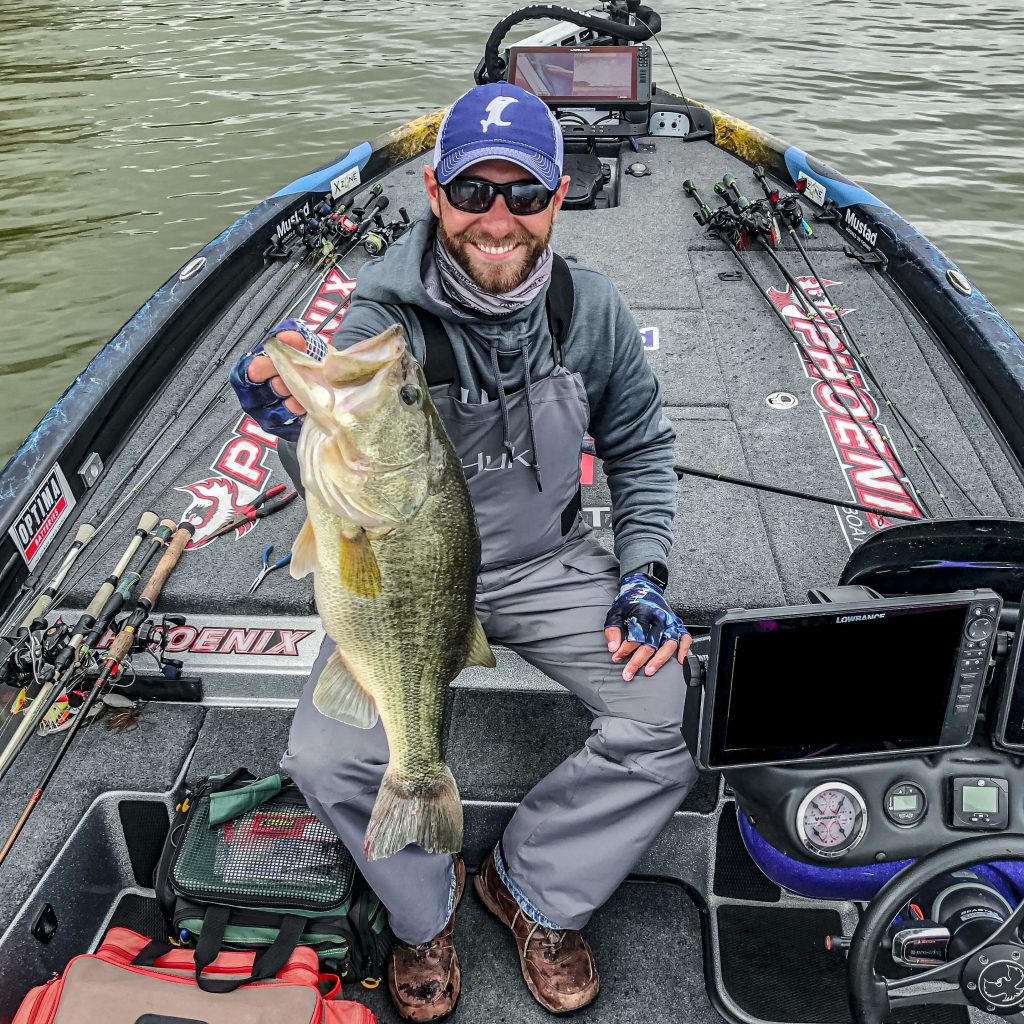The Texas rig was one of the first ways to rig soft-plastics weedless and fish them without the lure becoming hung. Probably the first plastic worms were invented to mimic night crawlers or earthworms, but there also are soft-plastic lures that resemble crawfish, lizards, creature baits and baitfish.
How to Texas Rig a Soft-Plastic Worm
I believe there’s been more bass caught nationwide on some form of Texas-rigged soft-plastic lure than any other lure,” says Brandon Lester of Fayetteville, Tennessee. Lester fishes the Bassmaster Elite Series and Central Open Circuit, has been a bass pro for eight years, has qualified for seven Bassmaster Classics and has earned about $800,000 in tournaments.
Several different styles of soft-plastic lure hooks are available and include the extra-wide gap-style hooks, round-bend type hooks and straight-shank style hooks.
Lester says, “On a six or an eight inch plastic worm, I’ll use a 3/0 Mustad Grip-Pin Big Bite Soft Plastics hook that’s a round-bend hook to create the connection between the bass and the angler.

You must have the correct size and type of Texas rig hook whenever fishing a soft-plastic lure. There’s a grip-pin in this hook’s eye, a straight piece of metal that has barbs on its sides that keeps the soft-plastic lure firmly attached to the hook. The lure doesn’t slide down the hook when the bait’s being cast, becomes tangled-up in structure or is attacked by a bass.
This small piece of metal also helps your bait swim straight as you retrieve it or work it through structure or along the bottom. This hook provides more clearance between the point and the eye of the hook. When an angler sets this hook in the bass’s mouth or jaw, its round bend creates a better and stronger hook set in my opinion that’s better than I get from other styles of hooks.
How to Rig a Plastic Worm on the Grip-Pin Big Bite Hook
Put the point of the hook about 1/4-inch from the plastic worm’s nose, and push the hook all the way through the worm forward toward the eye of the hook and onto the Grip-Pin.
Then the hook will hold the worm in the correct position to come straight through the water. Next take the tip of the hook, and put it in the bottom of the worm, so the point is just below the worm’s top skin. Since the point of the hook is barely below the worm’s top skin, once the angler sets the hook hard, the hook will pop out and go quickly into the bass’s jaw.
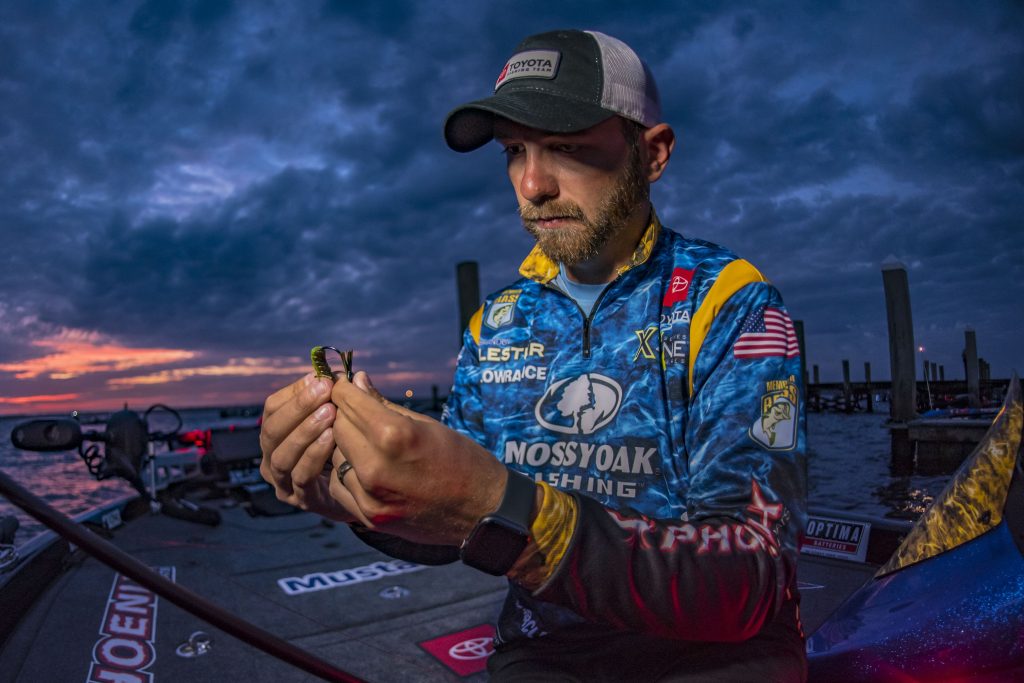
You can fish your Texas-rigged worm through almost any cover or bottom without the worm getting hung like it will if the point of the hook’s exposed outside the worm. Due to the Grip-Pin hooks, the fish usually can’t pull the worm down the hook.
An angler can catch and release a bass quickly and only have to simply put the hook back in that same worm and keep on fishing. I’ve caught five bass before with the same plastic worm out of a school because of this Big Bite hook, and the way I Texas-rig it in my worm.
How to Fish the Entire Water Column with a Texas-Rigged Worm
If you don’t put a weight above the eye of a hook, you can cast the lure out and swim it on top of the water and/or through vegetation. If you place a small tungsten weight on the line in front of the hook, you can swim the worm on top of the water.
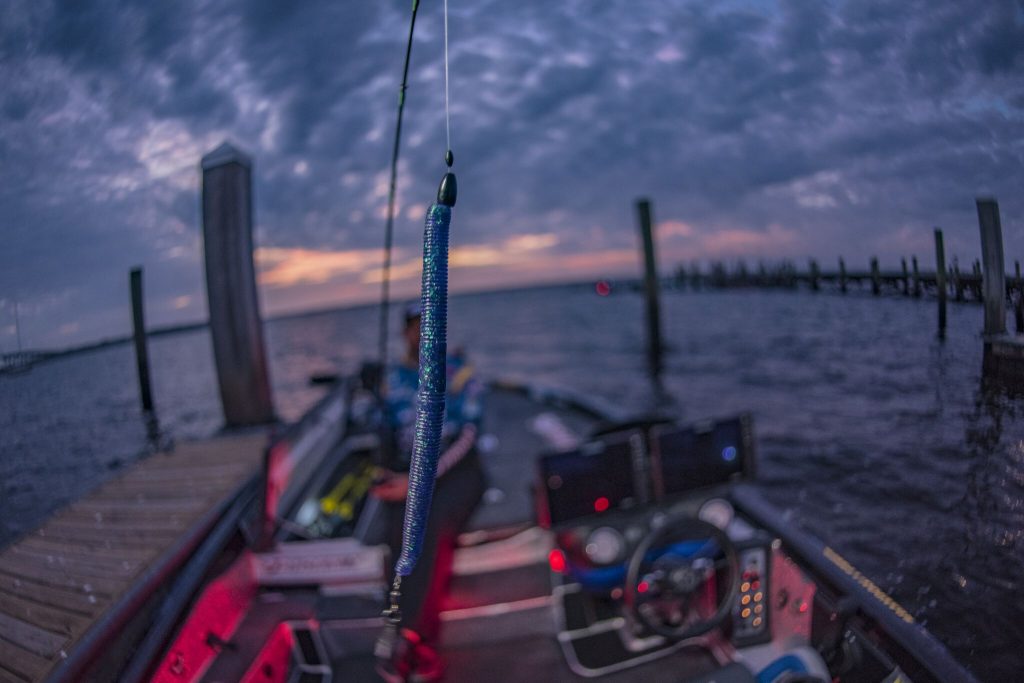
Then you can lower your rod tip when the worm comes to a hole in the vegetation, in a blowdown or in any other open water where you want your worm to fall. You can put a somewhat-heavier weight on the worm’s front and swim it along lily pads, brush tops, riprap or underwater structure for bass. Or, use a heavier weight, and punch through matted vegetation where bass concentrate on sunny days to attack bait fish.
Choosing The Proper Texas Rig Weight
The first two considerations are what type of cover you’re pitching or casting your worm to, and through what depth of water do you want to retrieve that worm. If I’m fishing shallow water and want to swim my worm on top of or near the surface, I’ll use a Mustad tungsten weight like a 1/8-ounce slip sinker to fish in water one to four feet deep.
On main river ledges like on the Tennessee River chain, to fish that worm on the bottom down to 15-25 foot deep water, to stay in contact with the bottom, I may use a 1/2-ounce tungsten worm weight.
Years ago, the only weights anglers could buy were lead weights. But tungsten weights give the angler a much-better feel of the bottom and the structure through which he’s fishing.
If I’m fishing a plastic worm in 15-25 foot deep water, a tungsten weight, which is much denser than lead, will allow me through my rod and line to feel the differences in the bottom – whether its running across a mussel shale bar or a gravel, boulder, mud or clay bottom.
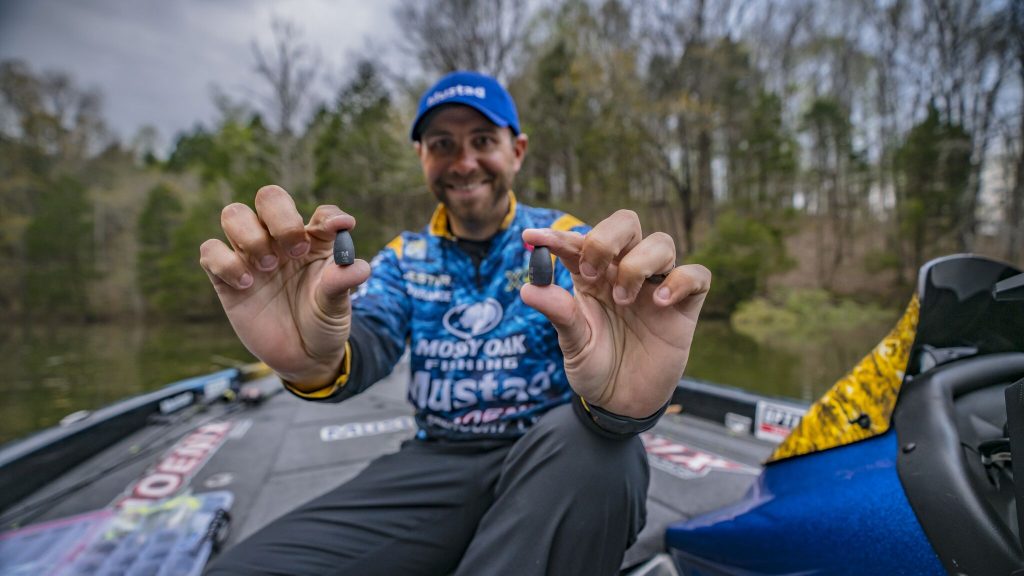
The tungsten weight enables me to feel even the lightest fish bite. Often, I’ve heard anglers say, “My electronics are my eyes under the water,” and that’s true. However, being able to feel the bottom and those light bass bites gives me a better picture in my mind of what type of bottom my tungsten weight is coming across.
A tungsten 1/2-ounce weight also is smaller than a 1/2-ounce lead weight because tungsten is much denser than lead. When using a 1-1/2-ounce weight to punch through a grass mat to enable my worm to fall under the grass where the bass can attack it, I’ll have a huge chunk of lead up the line from my worm with a 1-1/2-ounce lead weight.
But a 1-1/2-ounce tungsten weight is much smaller, slides through the grass mats easier than lead does and also appears much-more natural.
How to Punch Mats with Tungsten Weights
In the summertime, in lakes with an abundance of vegetation, punching holes in the vegetation with a weight lets your soft-plastic lure get through the grass into the places where bass hold. When I’m punching mats, I’ll use 60-pound-test braided line and either a 1- or a 1-1/2-ounce tungsten weight up the line.
My hook will be either a 3/0 or a 4/0 Mustad Grip-Pin Max Flipping hook. I’ll usually fish a small, 3/4-inch, soft-plastic creature bait like a Rodent, a Wild Thang or a Beaver Texas style that will slide through the grass without getting hung.
Texas Rig Fishing on Blowdowns, Stumps, Boulders and Docks
Before I start pitching or flipping a soft-plastic lure to a blowdown, a stump, a boulder or a dock, I want to determine what part of that underwater structure offers the bass the most shade and/or the most cover to ambush bait. Generally, that’s where several bass may be holding.
When fishing a blowdown by flipping a creature bait, a worm or any other type of soft-plastic, I’ll start fishing the very top of the tree down under the water. I don’t flip the middle of the tree to start with. I want to pick the bass out of that tree just like handpicked cotton, from the outside in.

I start with the easiest bass to catch that are the least likely to get hung-up in the tree if I hook them on the outside limbs or up in front of the outside limbs. Then the bass won’t run back into that tree and spook all the other bass holding there, as well as the bass on the trunk of the tree all the way back to the shoreline.
Many bass anglers won’t flip soft-plastic lures into the thickest parts of underwater trees because of their fear of success. “If I hook a bass in all those limbs, I’ll probably never be able to land it before it gets off my hook.” You’ll lose some bass but also catch some bass.
If you don’t pitch your lure into that thick part of the tree, you won’t get the bites and have the option of catching or losing the bass.
Follow these steps if you get a bite in any thick, underwater cover:
- set the hook hard on the bass when it takes the bait;
- keep steady pressure on the line, and move your boat to the spot where the bass is hung-up;
- move as close as you can to the line;
- put your hand on the line, reach down under the water – maybe up to your shoulder – and grab your bass by the jaw to pull the bass out.
Why Texas-Rigging a Soft-Plastic Bait Is Such a Popular Way to Bass Fish
The Texas rig is one of the most-versatile ways to find and catch bass. You can use the Texas rig to: punch grass; fish clear or dirty water; cast it; flip it; and fish soft-plastic swimbaits. I think this technique may have originated in Florida where there are large areas of grass.
For texas rig fishing a swimbait, I use a 1/8- or a 1/16-ounce tungsten weight and a 5/0 Mustad Big Bite hook. I’ll use the hook to go through the nose of a soft-plastic swimbait, and turn the hook to put the hook into the swimbait and rig it Texas style.
With this tactic you can cover a vast amount of water and catch some nice-sized bass. The good news is that with Texas-rigged plastics youngsters and novice bass anglers can fish for bass without their lures staying hung-up much of their fishing days. They simply can cast their plastics out, reel them in and catch a bass.
How to Decide the Colors and Sizes of Soft Plastics You’ll Fish, and How to Rig Them
Colors of Soft Plastics: I select the color of soft plastic I’ll fish for bass Texas-style based on water clarity. In clear water, I prefer natural-looking colors like the dependable green pumpkin, watermelon and watermelon red. When you’re fishing muddy water, green pumpkin works there also, but you may want to fish dark colors like black, blue, Junebug or a lure with some chartreuse color in it.
Being overwhelmed with the huge selection of colors available for soft-plastic lures is easy. However, if you use three or four basic colors like the ones I’ve suggested, they’ll often be the colors you’ll need for any situation.
Sizes of Soft Plastics: Picking the length of the worm or other soft-plastic lures I’m Texas-rigging depends on the size of bass I’m targeting, and/or the size of foliage where I think the bass will be feeding. During the summer months, I usually prefer a larger worm or soft-plastic lure. I may throw 10.5- or 11-inch plastic worms when the water’s hot, and the bass are feeding on big baits.
But there are times in both the summer and the winter when the weather’s extremely hot or very cold when the bass aren’t very aggressive. During those conditions, I may fish a three or a four inch worm. The smaller baits will get you more bites generally. But the bigger lures usually will catch bigger bass.

Hooks for Soft Plastics:: If I’m fishing smaller baits like three to four inch worms, I’ll probably fish a 1/0 Grip-Pin Big Bite hook. On a 10.5-inch worm, I like a 4/0 hook; with a 12-inch worm, I’ll probably use a 6/0 hook. Mustad makes that Big Bite hook from a 1/0 size to an 8/0 size. You can match these hooks to almost any shape and size of soft-plastic lure you want to fish.
Weights for Soft Plastics: The size of tungsten weight I use is generally decided by the depth of water I want to fish. However, I don’t want my weight size and hook size to overpower my bait.
If you’re fishing a 3- or a 4-inch worm, don’t use a 6/0 hook or a 1-1/2-ounce tungsten weight because then the bait won’t look or perform naturally. On large worms, like the 11- and 12-inch worms, use a weight that will get your lure down to the water depth you want to fish but no heavier.
When to Set the Hook on Texas-Rigged Soft Plastics
Worms: Another question I’m asked is when to set the hook on a plastic worm or soft-plastic lure rigged Texas style. Generally, lure size determines when to set the hook when you feel the bite.
For instance, if I’m fishing a three to four inch plastic worm, as soon as I feel the bite, I’ll set the hook because the bait’s so small, a bass can suck it in quickly. If I’m using a 10-12 inch worm, and especially if someone’s a novice fisherman, I’ll advise him to count to three before setting the hook.
Swimbaits: If you’re Texas-rigging a swimbait, and your rod tip is at about the 10:00 position, when you feel the bass bite the bait, drop your rod tip down to about the 6:00 or 7:00 position, and take-up line as you’re dropping your rod tip.
Then point your rod tip right at the bass and set the hook. Waiting to set the hook on a big bait like a swimbait gives the bass plenty of time to get the lure all the way in its mouth and turn either to the left or to the right before you set the hook.

Wait on this type of hook set because the bass may be coming up behind the bait, trying to inhale the bait. If you attempt to set the hook as soon as you feel the bass, you’ll pull that lure right out of its mouth because the bass is facing you with its mouth open.
However, if you wait until the bass gets the whole bait in its mouth and turns, you’ll have a much-better angle to set the hook in the bass’s mouth solidly, than if you attempt to set the hook as soon as you feel the bass bite.
Drop Shot Rigs: When fishing a drop-shot rig, anglers will hook a two to three inch worm on a drop-shot hook – either through the nose of the lure or rigging it Texas style. I prefer to fish a four to six inch plastic worm with a 2/0 or a 3/0 Mustad Grip-Pin Edge Finesse hook.
Mustad designed this hook for finesse fishing with a perfect wire hook design. I’ll only be fishing 8-10 pound test line. Using this technique of Texas-rigging a lure, you’ll rarely miss catching a bass and will get a good hook set on that light line and wire hook.
Carolina Rigs:
I like to fish a Carolina rig on a mud or a gravel bottom, but this tactic doesn’t work as well when fishing in big rocks like riprap. It can get hung-up easily but will allow you to cover plenty of water quickly. You simply cast the Carolina rig out and drag the weight along the bottom. My main line will be a 17-pound-test fluorocarbon that I tie it to a three foot long, 15-pound-test monofilament leader.
Although I’ve experimented with leaders from two to eight feet, the three foot leader seems to get the most bites. I typically use a 2/0 Grip-Pin Big Bite hook and fish a six inch plastic worm or a small crawfish-type soft-plastic lure with a Carolina rig.
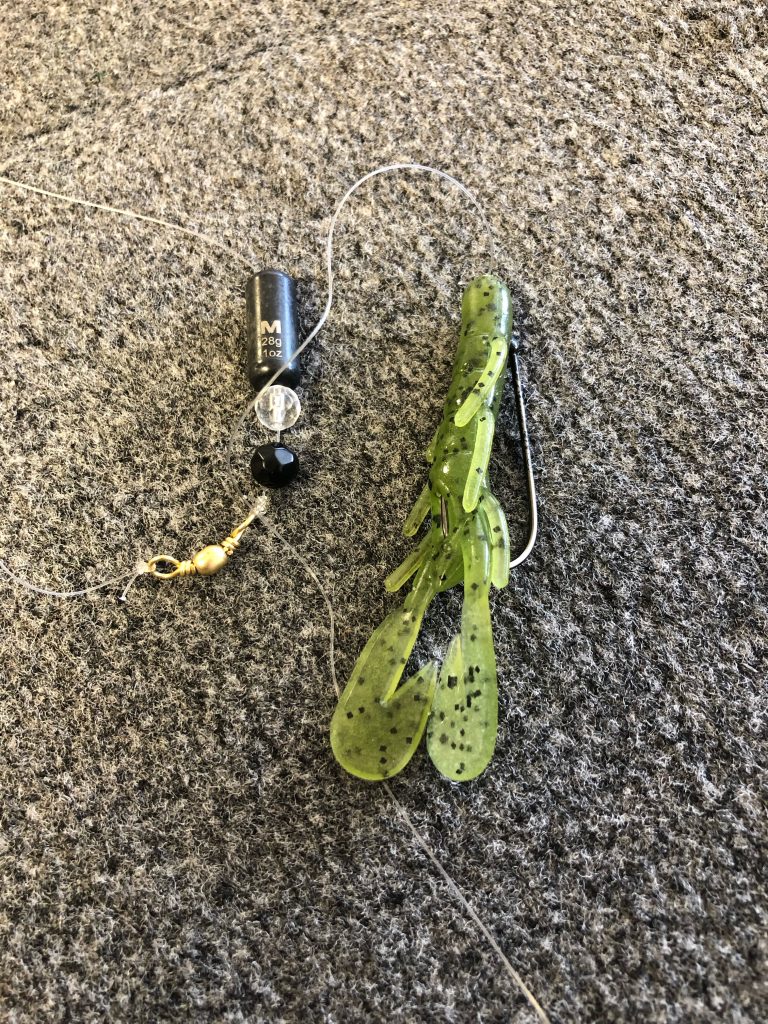
I like a barrel swivel to attach my main line to the leader and use a 3/4- or a 1-ounce Mustad Carolina Rig tungsten weight up the line with two glass beads beneath the weight.
The two glass beads have two purposes: once that weight slides down the line, it hits the glass beads instead of the knot that’s tied onto the barrel swivel and protects the knot from failing; and when you’re dragging that Carolina rig over the bottom, those beads make a clacking noise that seems to attract bass.
When anglers say, “Texas-rigged,” the words that usually follow are, “plastic worm.” However, you can use the Texas-style rig with many-other plastic lures. A Texas rig setup makes your lure more snag-proof.
You’ll have a tough time finding a plastic lure that doesn’t perform better when rigged Texas style. It prevents most hang-ups that other lures can’t dodge.

